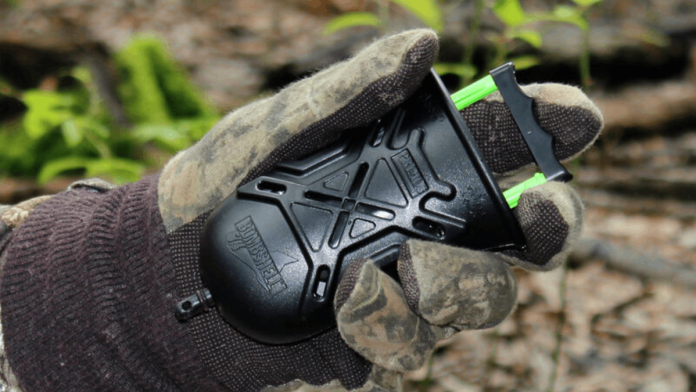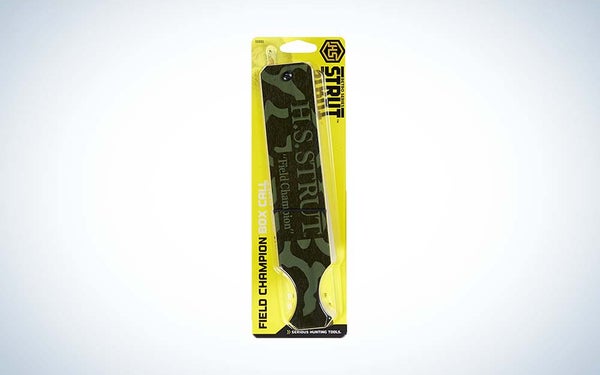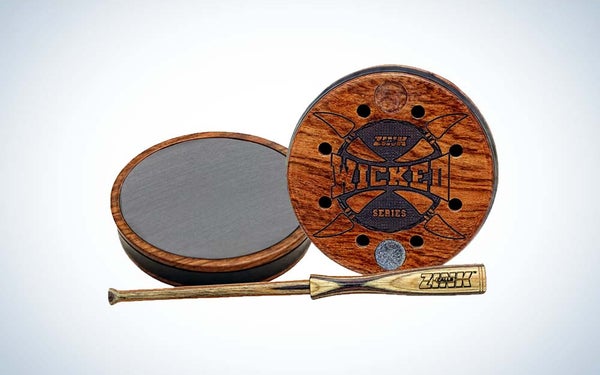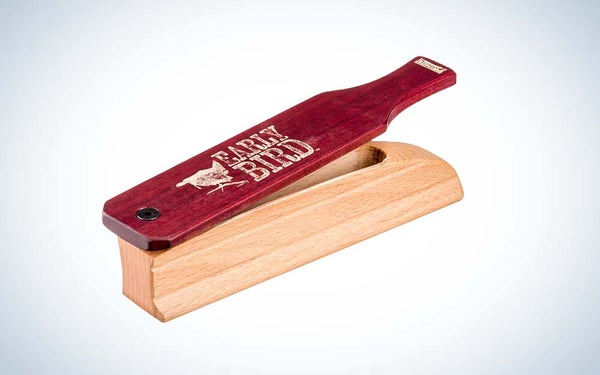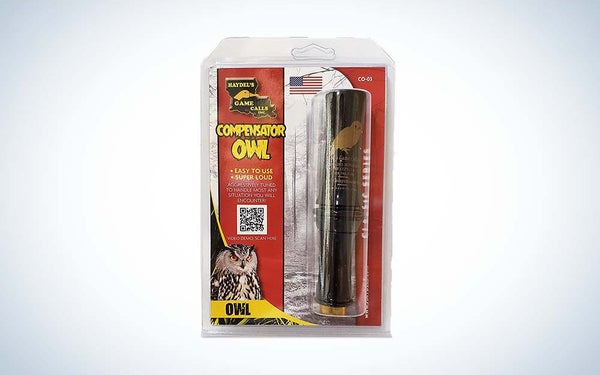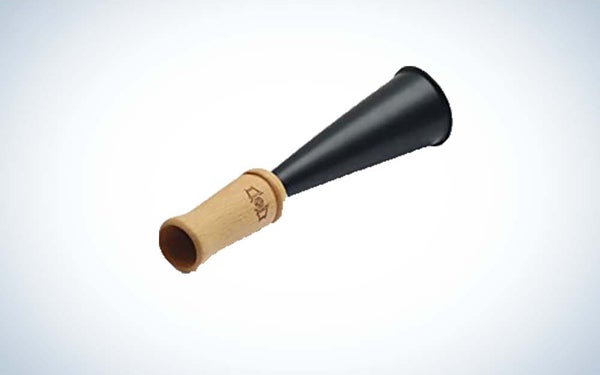We may earn revenue from the products available on this page and participate in affiliate programs. Learn more ›
Updated Feb 6, 2023 2:40 PM
My accumulation of turkey calls started a long time ago. I killed my first gobbler, an Ohio bird, back in 1990. My wife, Julie, killed her first, a Washington state Merriams, in 1994. Since then, she’s gone on to kill two Grand Slams. We even killed a slam as a couple in 2005, and have to date, put tags on 109 Spring longbeards.
Bragging? No. But I am awfully proud of her—she’s a fantastic turkey hunter—and I am proud of our field accomplishments together over the past three decades. I provide this background primarily as proof that as serious turkey hunters, we’ve gone through and currently have a lot of turkey calls. Box calls. Pot calls. Diaphragm calls. You name it, and there’s a good chance that during the last thirty seasons, we’ve played with it at least once.
That all said, I went through my arsenal of calls and hand-picked some of my favorites. Below you will find recommendations on box calls, mouth calls, slate calls, owl calls, and more. These are the best turkey calls to help you bag a gobbler this spring.
How We Picked The Best Turkey Calls
Most of these picks are my go-to calls when I step into the field each Spring, and I have plenty of hands-on experience with all of them. There have been, as you might expect, some changes in my working turkey vest over the past three decades. Most noticeably in what calls I use on a regular basis. The Field Champion is still there, but I use it primarily as a locator call. The Primos A-Frame is always in a hard case in my pocket and used every day/all day throughout the season. And the H.S. Strut coyote howler has produced gobbles for me from Florida to Washington. Here’s how I made my picks for the calls below:
Personal Experience
These are the calls I either currently use or have used for years. If a call spends more than a single season in my vest—or more than a single hunt, for that matter—it has something going for it.
User-Friendliness Rating
Turkey hunting is hard enough without having to run a call requiring a 182 IQ. We wanted simple-to-use calls—some, like the Field Champion, being straight out-of-the-box calls—and that’s what you have here. But we didn’t want simplicity to overshadow good sound; fortunately, this line-up affords both.
Sound
Obviously, the best turkey calls, regardless of price tag, are those that sound good. And these listed here can all be made to sound good with a little bit of practice. Or, in some cases, a lot of practice. Either way, the common denominator here is affordable calls from reputable, well-respected companies with a history in the so-called turkey business. And each of them sounds like a real live mama turkey.
The Best Turkey Calls: Reviews & Recommendations
Best Overall: Hunter Specialties Silencer Plus Field Champion Box
Why It Made the Cut: It’s easy to use, reasonably waterproof (with some care taken), sounds great, and can be had for $20.
Key Features
- Double-sided call, with gobbler and hen sounds
- Great Old School Woodland Camo finish
- Waterproof
- Silencer Plus lid lockdown system
Pros
- Shallow learning curve; ridiculously easy to use
- Affordable
- Good highs and lows in terms of volume
- No chalking required
Cons
- It’s wood, so it’s not 100 percent waterproof
- It’s a box call which means a two-handed operation that involves timing
I’ll admit it. I’m not a huge box call guy. I’m partial to my glass (pot) call, and an A-frame style diaphragm with a Bat Wing cut. That’s just me. But more gobblers fall to folks running a box call each Spring than do to those working all the other types of calls combined. Why? Because box calls are easy to use and, when operated with even a smidgeon of skill.
As does Hunter’s Specialties’ Field Champion box call. True, I’m not a box guy, but you will always find an older model H.S. Field Champion in my vest for those times when nothing else seems to work. It might be pretty plain looking, even with the Old School Woodland camo pattern; however, looks don’t kill gobblers. Sound and skills kill gobblers, and this one puts out plenty of those great sounds. Yelps, purrs, clucks, whines—this one does it all. Rattle the call, and you can get a pretty good gobble out of the thing. Whether it’s the first year or the 51st year turkey hunting, the Field Champion deserves a home in your pack.
Best Mouth Call: Primos A-Frame Triple with Bat Cut
Why It Made the Cut: This is, without question, my absolute Go-To diaphragm call.
Key Features
- Triple reed call
- ‘Bat Cut’ in top reed
- Excellent cutter/cutting call
Pros
- Easy to blow
- Versatile repertoire of great turkey sounds
- Good volume, but can be downplayed with a bird gets close
- Great rasp
Cons
- Triple reed takes a bit of practice
- I don’t like the orange tape as much as I love the call
I’m not entirely sure when I discovered Primos’ Bat Cut series of calls, but I fell in love with them almost immediately. And, thanks to Iowa’s great population of wild turkeys during the early years of the 21st Century, I had the opportunity to work birds with the Bat Cut time after time after time. And it works.
It’s somewhat difficult with three reeds and one altered in terms of getting the hang of blowing the Bat Cut. Practice and patience are what did it for me. The call does have a tendency to get a little muddy if you aren’t annunciating—for lack of a better word—each note clearly. But when you do hit those notes, you get raspy yelps, and realistic cutting, whines, purrs, and short runs. I slipped a Bat Cut on opening day a few years ago, and it pretty much stayed there for a month.
Best Slate: Zink Wicked Series Slate
Why It Made the Cut: Zink calls are some of the best out there, and their turkey calls are no exception.
Key Features
- Cherry pot
- Dymondwood striker
- Slate calling surface
- Integral striker cleaner/conditioner on the backside
Pros
- Attractive visually
- Great turkey sounds
- Built-in striker tip conditioner
- The rubberized grip around the circumference makes holding the call easy
Cons
- Expensive
- Slate may not be as loud as glass or crystal
I shot my first specklebelly goose with Fred Zink in northern North Dakota back in the early 1990s, and I’ve been a fan of the boy from Buckeye Land ever since. A champion goose caller and waterfowl call designer, Zink built his reputation on making duck and goose calls. Turns out, he’s just as good at making turkey calls.
I love the rubber ring around the edge of Zink’s pot call because this makes gripping the Wicked Series with my fingertips a sure thing. And this grip helps me get as much sound clarity and volume out of the instrument as possible. It’s a plain and pretty call, with no skulls or bones or devil tongues. And it sounds like a million bucks. Soft and close; loud and far. This one does it all. However, I’m a fan of the flared-tip strikers, but swapping it for a Mad Calls purple heart/acrylic stick—my favorite— is pretty simple.
Best Budget: Primos Early Bird Box
Why It Made the Cut: It comes from one of the most respected names in the call making business—Primos. And it’s made of purple heart wood, which I love.
Key Features
- Purple heart and oak construction
- Weighted paddle
- Moisture resistant
Pros
- Great volume when needed; quiet when necessary
- Weighted paddle helps cut down on lid bounce
- Affordable
Cons
- Wood doesn’t do well in the rain
Will Primos’ name has become synonymous with some of the finest hunting calls available—and at prices that won’t put a serious hurting on your wallet. For right around $30, the Early Bird Box Call brings great sound and versatility to the table. It’s easy to use, and the combination of the oak body and purple heart lid makes a wide range of turkey sounds and volumes possible right out of the package. The heavier weighted paddle is a nice touch for easy control and feel. And, if it matters, the Early Bird doesn’t look too shabby, either.
Best Push Button Call: Quaker Boy ‘Cyclone’ Easy Yelper
Why It Made the Cut: If you have the ability to push a button, then you have the potential to call a gobbler to the gun. It’s that simple.
Key Features
- Waterproof
- Twist/turn volume adjustment
- Clucker button
- Mahogany sides; maple striker
Pros
- Very easy to use
- Adjustable
- One-handed operation
- Affordable
Cons
- Lacks the volume of larger box calls
To me, there’s just something missing with a push-button turkey yelper. True, they’re undeniably easy to use, and some, like the Cyclone, sound pretty darn good. I’ve just always been a glass and diaphragm guy. However, you’ll get no argument from me about Quaker Boy’s Cyclone. Push a button, and a good hen yelp emerges. Push it slowly, and the yelp becomes a purr. Lay your thumb on the maple lid, and the purr turns into a whine. With practice, cuts and cackles are on the menu too. As for the so-called clucker button, a light tap, and you’re clucking like an old mama turkey. Is a push-button like the Cyclone for everyone? No, but it is for anyone looking for something easy and a little different.
Best Owl Hooter: Haydel’s CO-03 Compensator Owl Call
Why It Made the Cut: One of the best locator calls on the market, this owl hooter is easy to blow and produces shock gobbles without problem.
Key Features
- Compensator design
- Durable polycarbonate construction
- A trio of sound holes in the port/end
Pros
- Easy to use
- No hand manipulation (back pressure) needed
- Compact
- Good volume
Cons
- Not as mellow as a wooden owl hooter
With the Compensator Owl Hooter, you just need to get the rhythm down—Who cooks for you? Who cooks for you all?—and the call essentially does the rest. The CO-03 has all the volume necessary to carry the distance and, more importantly, cut through any wind, reaching out and touching those old roosted gobblers. Built from a tough polycarbonate, the Compensator should last many seasons, regardless of the rigors.
Best Coyote Howler: Hunter’s Specialties/Drury Outdoors Signature Howler
Why It Made the Cut: I’ve packed one of these—first generation—coyote howlers for over 30 years now, and can’t tell you how many turkeys have gobbled at this thing. It works.
Key Features
- Injected molded reed system
- Hardwood barrel
- Durable hard plastic horn extension
Pros
- Incredible distance
- High pitch makes even tight-lipped longbeards gobble
- Simple to use
Cons
- May incite a riot among your local coyote population
Since my first gobbler, I’ve used somewhere in the neighborhood of 1.529 million locator calls. Peacock screams. Goose calls. Train whistles. Cow bawls. Slamming doors. Nothing instigated gobblers into sounding off to the degree that Mark Allen Drury’s (MAD) coyote howler has. Nothing.
This is as simple as it gets, and you damn near can’t screw it up. The pitch and volume? Off the charts, if that’s what you’re looking for. It gets on every last nerve—trust me—but that’s why it works so well. It’s no work of art, but doesn’t matter because it’s the sound you’re looking for. Not good looks.
Things To Consider Before Buying the Best Turkey Calls
There are three main criteria for choosing a turkey call—Physical ability, skill level, and personal preference. After that, there on some secondary considerations like price point and application. Remember these three things when buying your next turkey call:
Physical Ability
There may be physical considerations in play when it comes to choosing what type or style of turkey call you to decide upon. You might able to use one call well, and another not so much. Everyone is different. My father is a perfect example. As a full denture wearer, he can’t make a roof of the mouth diaphragm call do what it’s supposed to do. Nor can he make a pot style call work due to a slight neurological malfunction. But he can use a box call. Proof that there’s a call for everyone.
Skill Level
Of the three major categories of turkey calls – box calls, pot style calls (slate/glass/aluminum), and diaphragm calls – it’s the mouth calls that often prove the most troublesome for folks, particularly new turkey hunters/callers. There’s no question there’s a learning curve involved with diaphragms, and my best advice for someone wanting to learn is to stick with it. Watch instructional videos. And do not make it harder than it needs to be.
The box call is responsible for the demise of more gobblers every Spring than all the other types of calls combined. Why? Because it’s simple to operate and it sounds good. Now, I’m not implying there’s no learning curve associated with the box call—because there is—but for the novice, it’s most certainly the way to go.
My personal favorite? The pot style call, specifically, a glass call or the slightly more mellow glass-over-slate. I think it falls right in the middle between the box call and the diaphragm in terms of the learning curve. However, if you can hold and operate an ordinary lead pencil, you have the skills necessary to successfully operate a pot style call. Sure, there’s a little more involved, but not much.
Personal Preference
This might seem obvious, but sometimes you like a call, well, just simply because you like it. And that’s ok. I have my own favorites. I like the way they sound. The way they look. The way they feel. After you test out a bunch of calls, you’ll get a feel for what you like and what you don’t like.
FAQs
Q: Which is better: a glass or slate turkey call?
This question comes down to personal preference. Both are pot style calls used in conjunction with a peg, aka striker, and both are operated in the same fashion. A softer material than glass, slate calls will generally have a more mellow sound than will the harder glass, the latter often producing a clear, crisp tone of mid- to higher volume. As for the better of the two calls? The answer is really neither, as both are excellent choices for all styles of turkey hunting.
Q: Will a slate call work in the rain?
Maybe. A slate call can be used in the rain or when wet, if it’s played with a non-wooden striker made of carbon, acrylic plastic, or fiberglass. Why? Because wood and water generally don’t mix well, and such is the case here. If you’re hunting in wet conditions, it is best to choose a glass, glass-over-slate, or crystal (a hard glass) calling surface and match it with a non-wood striker.
Q: What is the loudest turkey call?
All three styles of turkey calls—box calls, pot calls, and diaphragms—can produce high volume sounds. However, the higher a call goes in volume, the less realistic or natural the calls become. Most would agree a box call can achieve the highest volume without a loss in realism, followed by the pot style calls, and then mouth calls.
Q: How long do turkey mouth calls last?
Typically, I’ll get one season out of my mouth calls if I take care of them. That means drying them, separating the reeds with a toothpick post-hunt, and storing them in a multi-call case in the refrigerator. Mouth calls, though, are relatively inexpensive, so if I have to replace one or more each Sprin, which I do, so be it.
Q: What is the easiest turkey call type to use?
If you can rub two sticks together, you can operate a box call, which is probably the easiest of the three call styles to use. However, I’m of the mind anyone can make sounds with all three types of calls. It’s knowing what the sounds mean to that old gobbler. That’s the challenging part of the equation. That said, box calls are the hands-down winner in terms of ease of use.
Q: What is the most difficult turkey call type to use?
A mouth call. The trick with a mouth call is to find one that fits properly, one that seals as it should, allowing you to present air between your tongue and the call positioned in the roof of your mouth. Practice makes perfect.
Final Thoughts on the Best Turkey Calls
When it comes right down to it, a turkey call is one of the tools in the turkey hunter’s toolbox. It is meant to be used when the time comes and the circumstances and/or situation dictate. My best advice when it comes to picking a turkey call? Find one you’re comfortable and confident with, and then practice and use afield that call until you become proficient with it. No need to buy 15 different calls and not be able to make realistic sounds with any one of them.

